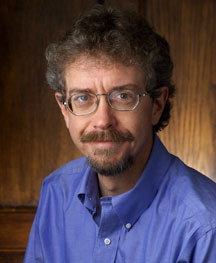

Scripps Research Hosts Prospective Students
By Mika Ono
Some 50 bright aspiring scientists traveled to San Diego from around the world last weekend to learn more about The Scripps Research Institute and its top-ranked graduate program.
The invited candidates, many of whom will choose to become part of the entering class at the Scripps Research Kellogg School of Science and Technology in the fall, started out their visit by gathering for coffee, bagels, and an overview of the program with Dean Jamie Williamson.
"Why is Scripps unique?" Williamson asked the prospective graduate students. "We have tremendous faculty, students, postdocs, staff, and administration. We have world-class facilities. The environment is highly conducive to helping you be the best scientist that you can be. You have the opportunities, the advantages, and the colleagues to hit the ground running and immerse yourself totally in research."
The Kellogg School graduate program, which currently has 222 students (23 on the Florida campus, 199 on the California campus), is ranked among the top ten in the nation, according to independent metrics by the U.S. News & World Report and the Chronicle of Higher Education. The Chronicle, for example, ranks the Kellogg School first in the nation in biophysics, second in immunology, and seventh in biochemistry.
Kellogg School students design their own curriculum according to their scientific interests in chemistry, chemical biology, biophysics, biology, and/or immunology. Four of the classes represent the students' core curriculum. Two additional classes are graded on a pass/fail basis to encourage students to explore topics outside their current areas of expertise.
"It never ceases to amaze me the imaginative combinations of courses students come up with," said Williamson.
Up to three lab rotations help pair graduate students with advisors. In addition, students select three faculty members to serve as an "annual committee." These faculty members offer support and guidance throughout the students' graduate work and eventually act as members of the students' thesis committee.
Opportunities to Excel
During their studies, Kellogg School students have the option to participate in several special offerings within the larger program. These include: the Skaggs Oxford program, in which students complete doctoral work at both Scripps Research and Britain's Oxford University, graduating with a joint Ph.D.-D.Phil. degree; the JUST program, in which graduate students interested in teaching have the opportunity to teach undergraduate classes at the University of San Diego; and the Clinical and Translational Science Award training program, in which graduate students participate in clinical seminars and pair up with a physician-mentor to facilitate research opportunities in the medical field.
In addition, new this year is the Training Program in Molecular Evolution, in which graduate students learn from and interact with a group of 18 outstanding principal investigators in the field. The program, led by Professor M.G. Finn, emphasizes the principles of evolution, the central relevance of evolutionary processes at the molecular level to problems of disease, and the use of molecular evolution as a laboratory tool.
At the end of his overview, Williamson asked the prospective students to introduce themselves by saying a few words on who they were and why they were there.
The answers varied. Some were finishing college; others had years of research experience. A few had already decided on one focused area of research; others were attracted to several larger disciplines. Their undergraduate institutions included major universities such as Harvard University, Stanford University, and the University of California at Berkeley, small colleges such as Reed College and Carleton College, and institutions located in locales as far away as Singapore, Taiwan, China, Korea, and Europe.
However, the prospective students had one thing in common—they seemed genuinely excited about being at Scripps Research.
Again and again, they cited Scripps Research's reputation for quality and for encouraging interdisciplinary studies in the sciences: "I want to go to the best"; "I'm attracted to the research-intensive environment"; "I like the emphasis on collaboration."
After the introductions ended, Williamson prepared the students for the day ahead. The schedule—which will be repeated for one more group of candidates the following weekend—included intensive interviews with some half dozen to a dozen faculty members, a tour of the Scripps Research California campus and specialized research facilities, and a lunch, reception, and dinner, which provided an opportunity to speak with the dean, current students, additional faculty members, and the Graduate Office staff.
"Take the opportunity to engage," advised Williamson. "Never think a question is dumb. Seize the moment. Don't just believe that this is a great place; go out and see for yourselves..."
For more information about the Kellogg School programs, see the Ph.D. site.
Send comments to: mikaono[at]scripps.edu

"The environment [at Scripps Research] is highly conducive to helping you be the best scientist that you can be," says Kellogg School Dean Jamie Williamson to prospective students.
